The food culture in the Basque region of Spain is truly amazing! San Sebastian is quickly becoming one of the top foodie destinations and for good reason. At the center of the Basque food, culture are pintxos. These are small bites, similar to a tapa that people are probably more familiar with. In general, pintxos are larger and more complex than most tapas offered in Spain. You can easily create an entire meal on pintxos, trust us we did this very often while we were in Bilbao and in San Sebastian.
It can be intimidating to walk into a pintxos bar when you aren’t fluent in Spanish and aren’t sure the protocol. Most pintxo bars are small places and the best ones are jam-packed with people. But don’t worry, we have some tips on how to order and what to order. The first stop on our Northern Spain trip was Bilbao. When we arrived we knew we had to eat pintxos but we weren’t exactly sure what to do. We walked into a pintxo bar and just watched for a few minutes so we could see what people were doing and get a lay of the land. We saw people pointing to the pintxos on the bar so that is what we did. Most pintxo bars have cold pintxos out on the bar or just behind the bar, on display. So if you don’t know any Spanish you can simply point to which ones you want. Most often pintxos are enjoyed with a drink so knowing how to order a beer or wine is helpful. Una copa de vino tinto or vino blanco will get you a glass of red or white wine respectively. You can ask for a cerveza and that will get you a beer but most locals will order a cana, which is a small glass of beer. Pintxos are meant to be eaten standing up and most locals go from place to place so don’t expect to sit at a table and stay at the same bar all night long.
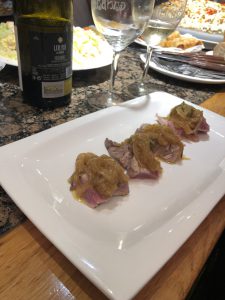
We spent the first two days of our trip eating only these pintxos we saw on display. We ate well and were not disappointed but we knew we weren’t getting the full pintxo experience. We learned more later on in our trip once we got to San Sebastian. Here we took a food tour our first night hoping we would learn more than what we had already picked up on based on our observations.
What we learned is that a lot of the pintxo bars have a hot pintxo (pintxos caliente) menu which is often listed on a board (often a chalkboard) on display on the wall behind the bar. Some of the bars will also have a paper copy on this menu and that may be offered in English. Hot pintxos can typically be ordered as pintxo size (small, bite-size portion), a half portion (media racion), or a full portion (racion) which is a larger portion similar to what you would expect if you ordered an entrée. Either way, most locals still enjoy their food standing up at the bar or a small counter.

Once we discovered how to get hot pintxos there was no going back to the ones on display on the bar. The pintxos we ordered in San Sebastian were some of the best things we have ever eaten. While there are many Michelin star restaurants in San Sebastian we decided to stick with pintxos each night we were there. That way you can still get amazing food but at a much lower price and get a real feel for the city as you wander the streets. You can get hot pintxos in Bilbao but as we were there before we really had it all figured out we don’t have as many specific recommendations for Bilbao as we do for San Sebastian. Here is our list of pintxo bars you must eat at while in each city.
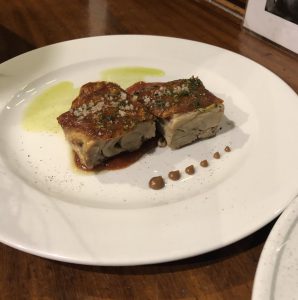
San Sebastian:
La Cuchara de San Telmo: We ate here three times! The first time our food tour guide brought us. We loved it so much that we went back the following two nights. Everything on their menu looked amazing. The guy behind the bar taking orders was also awesome! He remembered our name and took the time to say thank you and have a great night before we left. This is even more incredible when you see just how crowded this place is. Everything we had here was excellent, but you must try the Morcilla (blood sausage)! We also had the suckling pig, scallops, and pig’s ear – and everything we saw come out of the kitchen looked and smelled phenomenal. One thing to note is that they almost exclusively have ration/half ration order sizes (no pintxos and everything is made to order), but don’t worry – you will wish you had more.

Atari Gastroleku: We ended up going here twice. Once with our guided tour and once later in the week on our own. They are known for their Galician Octopus, and we also had the braised beef cheeks which are a traditional dish to the region. They are also known for their Gin & Tonics, so if you mind skipping the wine for a stop – this is the place.
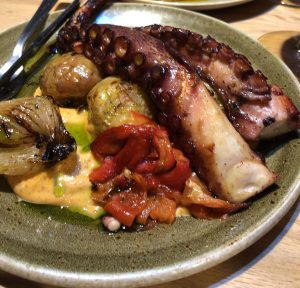
Ganbara: This place is known for its mushrooms, you will see a pile of different types and there are a few different dishes you can get made to order with mushrooms and they are all on the menu. We also went here with our guide, and he ordered tuna off-menu (called bonito in northern Spain, this place had it when it was in season).
Bar Sport: It was recommended by our Airbnb host who’s brother owns this place. Despite the bias, we agreed it was very good. We mostly had the cold pintxos, and the sea urchin soup was really good.
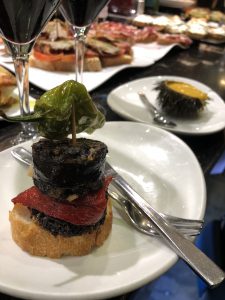
Bilbao:
Mercado de la Ribera: This is the largest covered market in Europe. You can buy fresh seafood, meats, cheeses, vegetables, and fruits here. There is also a large indoor sitting area surrounded by vendors selling a wide variety of pintxos.
El Sacachoros: This was the first pintxo bar we stepped into. We didn’t really know what to do, so we ended up ordering off the cold bar, then sitting down at a table. We had the octopus pintxo in the picture below, which was excellent. the Iberico ham one was good too though!
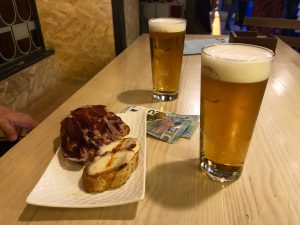
There are plenty of other pintxo bars in both these cities. Wander through old town in Bilbao or San Sebastian and go into any pintxo bar full of people. We promise you won’t be disappointed with the food!
For more in San Sebastian and Bilbao check out or other posts here:
Tell us your favorite pintxos and where you found them! Leave us a comment below!

